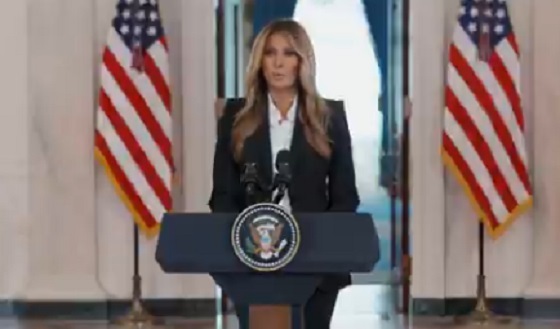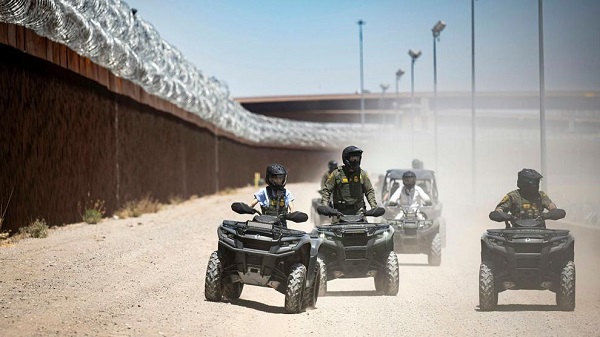International
Melania Trump quietly reunites children divided by Ukraine war

Quick Hit:
Melania Trump announced Friday that she’s maintained an “open channel” with Russian President Vladimir Putin, leading to the reunification of eight Ukrainian children with their families. The effort began with a personal letter she sent to Putin in August and has since expanded into coordinated talks between her representatives and Russian officials.
Key Details:
- During remarks in the White House grand foyer Friday, Melania Trump said, “A child’s soul knows no borders,” as she announced the reunification of eight Ukrainian children separated by the ongoing war.
- The first lady said she first reached out to Putin in a letter delivered during President Trump’s August 15 summit in Alaska, adding that “much has unfolded since President Putin received my letter.”
- Trump confirmed that “several backchannel meetings and calls” have since taken place, and that her representative has been working directly with Putin’s team to help connect displaced children with their families.
Announcement from First Lady Melania Trump @FLOTUS @WhiteHouse pic.twitter.com/zaOIhK8uAe
— Office of the First Lady (@FirstLadyOffice) October 10, 2025
Diving Deeper:
In an unexpected and emotional statement from the White House grand foyer Friday, Melania Trump revealed that her private outreach to Russian President Vladimir Putin resulted in the reunification of eight Ukrainian children with their families.
Trump said her involvement began with a letter to Putin, hand-delivered during President Trump’s August 15 summit in Alaska. “Much has unfolded since President Putin received my letter,” she said, describing how the correspondence evolved into a continuing dialogue between her office and Russian officials. “Since then, President Putin and I have had an open channel of communication,” she explained, adding that “several backchannel meetings and calls” have taken place to facilitate humanitarian coordination.
According to Trump, eight children have already been returned to their families within the past 24 hours — including one girl reunited with relatives across the Russia-Ukraine border — and “plans are already underway” for additional reunifications.
Trump framed the effort as part of her broader humanitarian mission to protect children affected by conflict. “A child’s soul knows no borders,” she said, emphasizing that political boundaries should never prevent the return of children to their loved ones.
She added that her representatives have been working directly with Putin’s team to locate and repatriate displaced minors. Several of the children involved in the latest effort were taken across borders during heavy fighting in eastern Ukraine, while others had been separated from relatives due to the chaos of war.
While details of the behind-the-scenes coordination remain limited, Trump’s announcement highlights the humanitarian possibilities that still exist even amid strained relations between the two nations.
illegal immigration
$4.5B awarded in new contracts to build Smart Wall along southwest border

Homeland Security Secretary Kristi Noem rides an ATV along the U.S.-Mexico border wall in El Paso, Texas, on April 28, 2025. Photo: Tia Dufour / U.S. Department of Homeland Security
From The Center Square
By
New contracts to add 230 miles of barriers, nearly 400 miles of technology
Roughly $4.5 billion in contracts have been awarded to expand border wall construction, including adding advanced technological surveillance along the southwest border.
Ten new construction contracts have been awarded through the U.S. Department of Homeland Security and U.S. Customs and Border Protection to add hundreds of miles of Smart Wall in California, Arizona, New Mexico and Texas.
“For years, Washington talked about border security but failed to deliver. This President changed that,” CBP Commissioner Rodney Scott said. “The Smart Wall means more miles of barriers, more technology, and more capability for our agents on the ground. This is how you take control of the border.”

Scott has championed advancing a Smart Wall border security system for years. A border security system is far more than a wall, he has told The Center Square, it’s an ecosystem.
The system encompasses steel and waterborne barriers, patrol roads, lights, cameras, advanced detection technology, including towers and aerostats, to provide Border Patrol agents with a range of tools to detect and interdict illegal activity.
CBP has published an interactive map to educate the public about the Smart Wall system. The map highlights areas of the 1,954-mile U.S.-Mexico border where wall construction has been completed, where border wall panels or waterborne barriers are under construction, where contracts have been awarded for proposed projects in the design phase or early construction, and planned construction areas that haven’t yet been awarded contracts.
Prior to Jan. 20, 2025, 702 miles of existing barriers had been constructed of primary wall and 76 miles of secondary wall, according to CBP data.
The new plan includes implementing barrier technology along 532 miles of the border where no barrier exists because of unfavorable terrain or remote location. It also includes deploying 550 miles of technology throughout previously constructed barriers, CBP says. Specific areas are also being built out in regions where contracts were previously canceled by the Biden administration.
In California, $483.5 million in taxpayer funding was awarded to BCCG Joint Venture for the Diego 1 Project to construct nine miles of new Smart Wall and 52 miles of system attributes in the San Diego Sector.
An additional $574 million was awarded to Fisher Sand & Gravel Co. for the El Centro 1 Project to construct eight miles of Smart Wall and install 63 miles of system attributes in the San Diego and El Centro sectors.
In California and Arizona, $199.5 million was awarded to Barnard Spencer Joint Venture for the Yuma 1 Project to construct 60 miles of system attributes in the Yuma Sector.
In Arizona, nearly $607 million was awarded to BCCG for the Tucson 1 Project to construct 23 miles of new secondary border wall and 66 miles of system attributes in the Tucson and Yuma sectors.
In New Mexico, $155.1 million was awarded to BCCG for the El Paso 1 Project to replace seven miles of old dilapidated barrier fencing in the Santa Teresa Area of Responsibility with a new Smart Wall. BCCG will also complete 22 miles of system attributes in the El Paso Sector in New Mexico.
Also in the El Paso Sector in New Mexico, Barnard Spencer Joint Venture was awarded nearly $579 million for the El Paso 2 Project to construct 23 miles of new Smart Wall and 81 miles of system attributes.
In the El Paso Sector in far west Texas, BCCG Joint Venture was awarded $850.4 million for the El Paso 3 Project to construct 42 miles of new primary Smart Wall, six miles of new secondary border wall and 46 miles of system attributes.
In Texas, BCCG Joint Venture was awarded $565 million for the Del Rio 1 Project to construct 22 miles of new primary Smart Wall, replace two miles of old barrier wall, and deploy 40 miles of waterborne barrier system in the Eagle Pass Area of Responsibility in the Del Rio Sector.
BCCG was also awarded $364.3 million for the Del Rio 2 Project to construct 10 miles of new primary Smart Wall, 23 miles of waterborne barrier system, and install 10 miles of system attributes in Eagle Pass.
BCCG was also awarded $96.1 million for the Rio Grande Valley Waterborne Barrier Project to deploy 17 miles of waterborne barrier in the Rio Grande River, south of Brownsville in Cameron County in the Rio Grande Valley Sector.
Another $550 million worth of contracts was also awarded to support Smart Wall construction. Additional construction and contracts are expected.
Funding for the projects comes from the “One Big Beautiful Bill,” which President Donald Trump signed into law. It also includes some fiscal year 2021 border wall appropriations that were frozen during the Biden administration.
Waivers were also issued by DHS Secretary Kristi Noem to expedite construction of nine miles in the San Diego Sector and 30 miles in the El Paso Sector in New Mexico. Both sectors were inundated with record high illegal traffic during the Biden administration.
Crime
Canadian Sovereignty at Stake: Stunning Testimony at Security Hearing in Ottawa from Sam Cooper

Canada’s Border Vulnerabilities: Confronting Transnational Crime and Legal Failures
The Bureau has chosen to publish the full opening statement of founder Sam Cooper before the House of Commons Standing Committee on Public Safety and National Security, during the session titled “Canada–United States Border Management,” held on Tuesday, October 7, 2025, and webcast live at https://www.ourcommons.ca/
https://www.ourcommons.ca/Committees/en/SECU/Meetings?utm_source=substack&utm_medium=email
I offer these remarks and recommendations with humility. I’m still learning every day. I speak regularly with numerous law-enforcement and security professionals in both the United States and Canada. For over a decade, I’ve focused professionally on the threats that transnational crime poses to Canada’s borders, institutions, and people, alongside deep reporting on our financial and legal vulnerabilities to threat networks that often include ties to hostile state activity. Canada’s recent terror designation of the India-based Bishnoi gang is important. But that particular action recognizes only one facet of the many-sided transnational fentanyl, human-trafficking, Chinese-supplied chemical precursor, weapons-trafficking, terror and extremism threats that I will discuss today.
Across hundreds of interviews with Canadian and U.S. experts, I have come to a conclusion: many Canadians — including citizens, lawmakers, and judges — do not yet fully understand the scope and nature of the problem, and also seem defensive in engaging it. And if we don’t understand it, we cannot solve it.
In these politically divisive times, I hope I can add value by relaying, clearly and fairly, what professionals on both sides of the border are saying about the cultural, legal, and political differences that impede cooperation between the United States and Canada. My reporting has emphasized Canadian enforcement challenges — not to be unduly critical of my homeland, but because I think we should focus first on the levers we control, and reforms we should have already tackled decades ago.
This isn’t my opinion only. As you know, Canadian Association Police Chiefs president Thomas Carrique recently warned that police are being asked to confront a new wave of transnational threats with “outdated and inadequate” laws “never designed to address today’s criminal landscape.” He added that Canada would have been far better positioned to “disrupt” organized crime had Ottawa acted on reforms first recommended in the early 2000s.
As RCMP Assistant Commissioner David Teboul said this year after the discovery of major fentanyl labs in British Columbia — notable for their commercial-grade chemistry equipment and scientific expertise — “There’s a need for legislative reform around how such equipment and precursor chemicals can be obtained.” More border regulations could help, but will not be sufficient absent foundational legal change.
It has long been my experience in discussions with senior U.S. enforcement experts that American and Australian police can collaborate effectively because the two nations are able to authorize wiretaps on dangerous transnational suspects within days. In Canada, that speed is impossible, and it has become a major obstacle.
As former RCMP investigator Calvin Chrustie testified before British Columbia’s Cullen Commission several years ago, due to judicial blockages arising from Charter of Rights rulings, it had become practically impossible to obtain timely wiretaps on Sinaloa Cartel targets in Vancouver. In recent years, such delays in sensitive investigations have undermined cooperation between the RCMP and the U.S. Drug Enforcement Administration in major cases of fentanyl trafficking and drug money laundering. In 2017, I was personally alerted to these longstanding concerns about the breakdown in RCMP–DEA cooperation by a U.S. State Department official.
These impeded investigations have involved the upper echelons of Chinese Triads, which maintain deep global leadership in Canada and align with Chinese state-interference networks, as well as senior Iranian and Hezbollah-linked networks operating here. Both networks are engaged in fentanyl trafficking and money laundering in collaboration with Mexican cartels active in Canada.
Canada must urgently reform what it can fix on our side.
My first recommendation is this — there is no “low-hanging fruit.” I have not spoken to a single knowledgeable Canadian officer — current or former — who believes that simply spending more on personnel, equipment, training, or border staffing will solve this. What I hear is that, from ten to twenty years ago, before the evolution of Charter-driven disclosure and delay jurisprudence in Canada, our nations enjoyed a much closer enforcement relationship. Experts point above all to two Supreme Court rulings — Stinchcombe and Jordan — as the core legal obstacles. Our Stinchcombe disclosure standards and Jordan time restrictions, as applied, disincentivize complex, multi-jurisdictional cases and deter U.S. partners from sharing sensitive intelligence that could be exposed in open court. Veterans describe enterprise files stalling for lack of approvals or because specialized techniques are denied. When police and prosecutors anticipate disclosure fights they cannot resource — and trial deadlines they cannot meet — the rational choice is to avoid the fight altogether.
I can explain in greater detail, but without question these rulings have devastated Canada’s ability to prosecute sophisticated organized crime. The result is a vicious circle of non-prosecution and impunity. To deny the need for deep legal reform is to deny the depth of the problem.
To sum up, my reporting at The Bureau has highlighted interlocking failures — legal, political, and bureaucratic — that have turned Canada into a permissive platform for synthetic narcotics and criminal finance, badly misaligning us with our Five Eyes law-enforcement and intelligence partners, and bringing us to the brink of a rupture with the United States.
Thanks for your attention, Chairman and Members.
The Bureau is a reader-supported publication.
To receive new posts and support my work, consider becoming a free or paid subscriber.
-

 National1 day ago
National1 day agoCanada’s birth rate plummets to an all-time low
-

 Crime1 day ago
Crime1 day agoPierre Poilievre says Christians may be ‘number one’ target of hate violence in Canada
-

 Opinion15 hours ago
Opinion15 hours agoJordan Peterson needs prayers as he battles serious health issues, daughter Mikhaila says
-

 COVID-1911 hours ago
COVID-1911 hours agoDevastating COVID-19 Vaccine Side Effect Confirmed by New Data: Study
-

 Alberta1 day ago
Alberta1 day agoJason Kenney’s Separatist Panic Misses the Point
-

 Censorship Industrial Complex16 hours ago
Censorship Industrial Complex16 hours agoWinnipeg Universities Flunk The Free Speech Test
-

 Red Deer5 hours ago
Red Deer5 hours agoThe City of Red Deer’s Financial Troubles: Here Are The Candidates I Am Voting For And Why.
-

 Automotive1 day ago
Automotive1 day agoBig Auto Wants Your Data. Trump and Congress Aren’t Having It.



